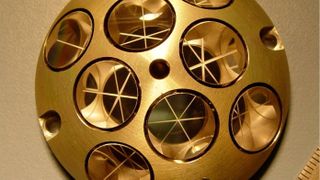
LRA (Laser Retroreflector Array) is a collection of eight retroreflectors that enable precise measurements of the distance between the orbiting or landing spacecraft and the lander.
(Image credit: NASA TV)
In the future, rocketing in making precision landings on the moon’s craggy, rocky and crater-pocked face won’t be as hard.
At least that’s the goal of NASA’s Lunar Retroreflector Array (LRA) program, an initiative that is interfacing with U.S. and foreign lunar lander initiatives. LRA consists of a dome-shaped device, topped by small glass prism retroreflectors. That contrivance is then mounted to a moon lander and delivered to the lunar surface.
The LRA can bounce laser light from other orbiting and incoming spacecraft, functioning as a permanent location marker on the moon for decades to come.
But dotting the lunar landscape with these devices has been a tough row to hoe.
Related: The age of the private moon mission has begun
High-stakes, hit-or-miss missions
The privately-built Astrobotic lander, dubbed Peregrine, is one of NASA’s Commercial Lunar Payload Services (CLPS) partnerships, enabling commercial companies to fly space agency scientific instruments to the moon.
Onboard the now trouble-plagued Astrobotic lunar lander was a NASA LRA. That lander suffered problems shortly after launch, curtailing any hope of getting its legs firmly down on the moon.
But there’s hope for the upcoming attempted landing of Japan’s Smart Lander for Investigating Moon (SLIM), another on course for a Jan. 20 touchdown. It too carries a NASA-supplied LRA.

An LRA consists of eight tiny retroreflectors mounted on a small, high hemispherical platform. (Image credit: NASA TV)
LRAs are to be carried by several up-and-coming CLPS-supported moon missions, such as the Intuitive Machines Nova-C lander. Then there is the Astrobotic Griffin lander, which also will be carrying an LRA – a very high-stakes undertaking as it carries NASA’s Volatiles Investigating Polar Exploration Rover, or VIPER.
But don’t forget the already-on-location LRA that was toted to the moon by India’s successful Chandrayaan-3 lunar lander in August of last year.
Multiple landmarks

LRA principal investigator Xiaoli Sun points out the reflective properties of the device. (Image credit: NASA TV)
The LRA payloads are under the CLPS program, but the LRA units provided to international partners were done under international memoranda of understandings inked between NASA and the respective space agencies, explains Daniel Cremons, deputy principal investigator for Laser Retroreflector Array at NASA Goddard Space Flight Center in Greenbelt, Maryland.
Cremons says that each LRA is a distinct location marker on the surface.
“Just as we use multiple landmarks to navigate in our daily lives on Earth,” Cremons says, having a greater number of location markers distributed on the lunar surface “make it easier and quicker to determine your own position in lunar orbit.”
The LRA project defines “operational” as the lander carrying LRA safely setting down on the lunar surface, Cremons adds, “which makes [India’s] Chandrayaan-3 the only operational one unit right now.”
Cremons also helped integrate an LRA on the SpaceIL Beresheet lander in November 2018. Beresheet was Israel’s first lunar mission and the first attempt by a private company to land on the moon. That spacecraft, however, was lost during an April 2019 landing attempt.
LRA requires no power

Intuitive Machines (IM-1) Nova-C lander mission is outfitted with a Laser Retroreflector Array (LRA). (Image credit: NASA TV)
At NASA Goddard Space Flight Center there is a small team dedicated to designing and building, as well as flight-qualifying the tiny LRA.
The LRA units that have already flown and are manifested on upcoming CLPS missions were all fabricated in 2019 as a single lot, says Cremons. “The LRA design was optimized for laser ranging from orbit to a lander or rover on a planetary surface.”
The Laser Retroreflector Array (LRA) is too small to be used from Earth. They are intended to use reflected laser light from a laser altimeter or Light Detection and Ranging (LIDAR) gear on a spacecraft orbiting the moon or headed for full-stop on the lunar terrain.
An LRA consists of eight tiny retroreflectors mounted on a small, high hemispherical platform. Total mass of the LRA is 20 grams, and requires no power.
Nascent stage
According to LRA documentation, “retroflectors, unlike simple plane mirrors, reflect radiation from a broad range of incident angles back to its source, with minimal scattering, and brighter reflection.”
From the U.S. side of things, another LRA is being carried by Intuitive Machines’ Nova-C lander, scheduled to drop in on the crater rim of Malapert A near the south pole of the moon. The Nova-C lander is expected to launch on a Falcon-9 rocket on its IM-1 mission later this year.
As noted by Intuitive Machines, LRAs are useful as precision landmarks for guidance and navigation during the lunar day or night. “A few LRAs surrounding a landing site can serve as precision landmarks to guide the arriving landers by aiding in autonomous and safe landing,” the company explains.
Cremons says that the vision is having future orbiters outfitted with a laser ranging system to regularly range to LRA units to refine a spacecraft’s orbits around the moon or calibrate pointing control.
“LRA will be particularly useful at or near the lunar south pole where image-based navigation is difficult due to the lighting conditions,” says Cremons. “Since LRA is designed to be operational for decades, I’m sure there are opportunities for use of the LRA ‘network’ we have not even considered at this nascent stage.”
Join our Space Forums to keep talking space on the latest missions, night sky and more! And if you have a news tip, correction or comment, let us know at: [email protected].
Breaking space news, the latest updates on rocket launches, skywatching events and more!
Leonard David is an award-winning space journalist who has been reporting on space activities for more than 50 years. Currently writing as Space.com’s Space Insider Columnist among his other projects, Leonard has authored numerous books on space exploration, Mars missions and more, with his latest being “Moon Rush: The New Space Race” published in 2019 by National Geographic. He also wrote “Mars: Our Future on the Red Planet” released in 2016 by National Geographic. Leonard has served as a correspondent for SpaceNews, Scientific American and Aerospace America for the AIAA. He was received many awards, including the first Ordway Award for Sustained Excellence in Spaceflight History in 2015 at the AAS Wernher von Braun Memorial Symposium. You can find out Leonard’s latest project at his website and on Twitter.
>>> Read full article>>>
Copyright for syndicated content belongs to the linked Source : Space.com – https://www.space.com/the-universe/moon/nasas-lunar-retroreflector-network-could-make-landing-on-the-moon-much-easier






























